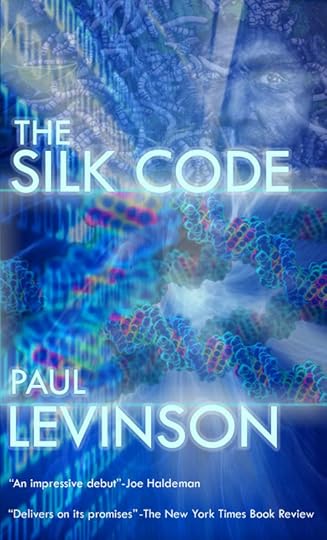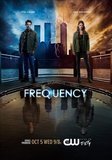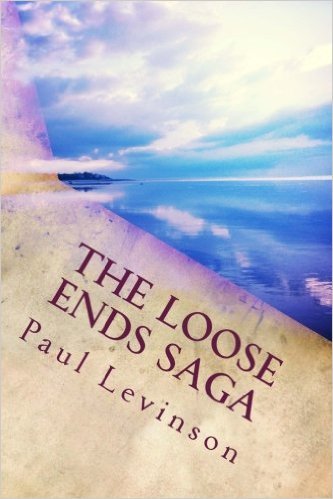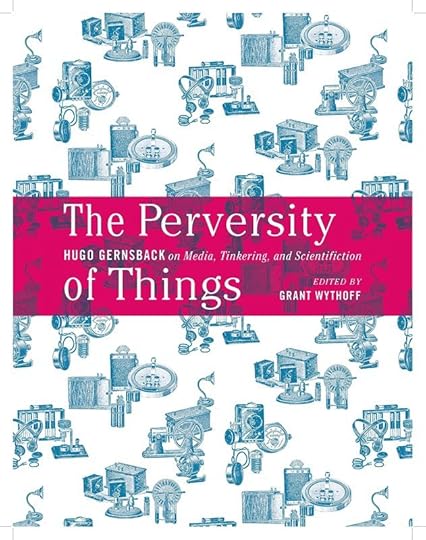Paul Levinson's Blog: Levinson at Large, page 230
January 14, 2017
The Difference Between Fantasy and Science Fiction
If you click your heels together three times and say there's no place like home, and that gets you across the universe, that's fantasy. If you click your heels together three times, and the spark that results touches a vulnerable spot in the space-time continuum that causes a wormhole to open, and you travel across the universe that way, that's science fiction. Paul Levinson's books ... Paul Levinson's music
Published on January 14, 2017 21:23
January 12, 2017
Colony 2.1: Prelude
 Colony was back tonight with the debut of its second season, with an episode that was mostly prelude, and, like the first season, pretty good.
Colony was back tonight with the debut of its second season, with an episode that was mostly prelude, and, like the first season, pretty good.A couple of general impressions: Colony now feels a little like FlashForward (cars suddenly stopping when the aliens arrive), Lost (prelude flashback), and even Fear the Walking Dead (the dawn of apocalypse). All of that of course makes sense - especially given that star power from Lost (Josh Holloway) and The Walking Dead (Sarah Wayne Callies, not Fear the Walking Dead, buy close enough) are in Colony.
Colony was also a successor, from day one, to Falling Skies and its alien invasion, except we never saw the aliens per se in the first season. Now we finally get to see ... well, not quite the aliens, but more of their ships and hardware. We did see a big tall something, but it's not clear if that's an alien, robot, or even a tall co-opted human.
The prelude was generally satisfying, though - and, like everything else these days, like The Man in the High Castle, especially disquieting because ... you know why, look at who's set to be sworn in as President next week. So Trump has had the unintended benefit of giving any show about a near-future or alternate history totalitarian state in the US a little more of an edge than it otherwise would have had.
But this first episode of the second has set the board nicely, and put the pieces in motion. The first season had lots of potential, only some of which was realized. I get the feeling that the second season will do better, and I'm looking forward to it.
See also Colony 1.1: Aliens with Potential ... 1.2: Compelling ... 1.5: Questions ... 1.6: The Provost ... Colony 1.7: Broussard ... Colony 1.8: Moon Base and Transit Zones ... Colony 1.9: Robot Arm ... Colony Season 1 Finale: Not Quite Enough

not exactly aliens, but strange enough ... The Silk Code
Paul Levinson's books ... Paul Levinson's music
Published on January 12, 2017 21:29
Vikings 4.17: Ivar's Wheels
 A superb Vikings 4.17 last night, on more than one level.
A superb Vikings 4.17 last night, on more than one level.The best scene was Ivar riding the one-horse chariot Floki made for him, at Ivar's request. He didn't quite get the chance to dispatch Lagertha - thanks to another great scene, with Bjorn arriving just in the nick of time. But Ivar gets to have wheels - and wings, as Floki says - after Ivar comes to Floki with his request. It was a very satisfying, high-point conversation, not just for Ivar but Floki, who has been yearning to do something really useful, if for not Ragnar, than for the most extraordinary of his sons.
Ivar and Floki have a lot in common. They're both outsiders, Ivar for physical reasons, Floki for well, mental reasons, and this makes the alliance between them very appropriate. I hope it's not the last we see of Floki.
But speaking of lasts, what a wonderful farewell scene between Bjorn and Rollo, followed with Rollo back with his royal family in Paris. The Vikings so far have not taken Paris - except, in a sense, via Rollo by marriage. But the French beat all of the Vikings the first time, and they did the same second time, when the French had the benefit of Rollo's guidance and valor. But the Vikings did come razor close - and we can understand fully Bjorn's statement to Rollo that Bjorn would have to kill Rollo if he stayed with his Viking people. Or, at least, try to kill Rollo, because I'm not convinced who would win such a one-on-one battle.
I am convinced that the Vikings are set to do real damage to at least some of England's royalty. But that's a story for next week, when I'll be back with another review.
See also Vikings 4.1: I'll Still Take Paris ... Vikings 4.2: Sacred Texts ...Vikings 4.4: Speaking the Language ... Vikings 4.5: Knives ... Vikings 4.8: Ships Up Cliff ... Vikings 4.10: "God Bless Paris" ... Vikings 4.11: Ragnar's Sons ... Vikings 4.12: Two Expeditions ... Vikings 4.13: Family ... Vikings 4.14: Penultimate Ragnar? ... Vikings 4.15: Close of an Era ... Vikings 1.16: Musselman
And see also Vikings 3.1. Fighting and Farming ... Vikings 3.2: Leonard Nimoy ...Vikings 3.3: We'll Always Have Paris ... Vikings 3.4: They Call Me the Wanderer ... Vikings 3.5: Massacre ... Vikings 3.6: Athelstan and Floki ...Vikings 3.7: At the Gates ... Vikings 3.8: Battle for Paris ... Vikings 3.9: The Conquered ... Vikings Season 3 Finale: Normandy
And see also Vikings 2.1-2: Upping the Ante of Conquest ... Vikings 2.4: Wise King ... Vikings 2.5: Caught in the Middle ... Vikings 2.6: The Guardians ...Vikings 2.7: Volatile Mix ... Vikings 2.8: Great Post-Apocalyptic Narrative ... Vikings Season 2 Finale: Satisfying, Surprising, Superb
And see also Vikings ... Vikings 1.2: Lindisfarne ... Vikings 1.3: The Priest ... Vikings 1.4: Twist and Testudo ... Vikings 1.5: Freud and Family ... Vikings 1.7: Religion and Battle ... Vikings 1.8: Sacrifice
... Vikings Season 1 Finale: Below the Ash

historical science fiction - a little further back in time
Paul Levinson's books ... Paul Levinson's music
Published on January 12, 2017 17:14
January 11, 2017
Frequency 1.11: The Unkilling
 Frequency is winding down to what are likely its three final episodes, and tonight's episode 1.11 kept up the pattern of the series getting better and better.
Frequency is winding down to what are likely its three final episodes, and tonight's episode 1.11 kept up the pattern of the series getting better and better.We left Raimy last week having just killed the Nightingale serial killer - something she could afford to do, in front of everyone, just for the understandable satisfaction she was giving into, because she believed her father Frank was going to kill, or was in the process of killing, the Nightingale 20 years earlier, before the Nightingale had a chance to kill Julie, Raimy's mother.
But fate intervened in the form of a drunk diver, who t-boned Frank's car, which allowed the Nightgale to escape.
The aftermath and its resolution - temporary resolution, of course, since there are still two remaining episodes - was handled very well tonight. Raimy is on the verge of being charged with murder, until something changes - she didn't kill the Nightingale after all in 2016, because he wasn't where he was last week in 2016. Frank did something in the past to change that. The scene in which the new reality seeps in for Raimy had a fine mix of calm and shocking, all at once.
Unfortunately for Frank and Raimy - but fortunately for the continuing story - that didn't kill the Nightingale in 1996. In another good scene, Julie pleads with Frank not kill the Nightingale - stressing what it would do to young Raimy, to see her father charged with murder, ironic indeed since Raimy in 2016 has been driving Frank in 1996 in this whole story to kill the Nightingale. But Frank comes through, surprisingly well, and gets the Nightingale arrested. Not as safe for Julie as the Nightingale dead, but it gets Frank back in the arms of Julie at home.
And there's also a satisfying rapprochement between Frank and Satch, making this episode one of the best for our people getting together.
Only two more episodes left - unless someone does something to our timeline which results in Frequency being picked up for a second season somewhere. Hey, I love time travel, so can always hope.
See also Frequency 1.1: Closely Spun Gem ... Frequency 1.2: All About the Changes ... Frequency 1.3: Chess Game Across Time ... Frequency 1.4: Glimpsing the Serial Killer ... Frequency 1.5: Two Sets of Memories ... Frequency 1.6: Another Time Traveler? ... Frequency 1.7: Snags ... Frequency 1.8: Interferences ... Frequency 1.9: The Wife and the Fiancee ... Frequency 1.10: The Clarinet of Time

more time travel
Paul Levinson's books ... Paul Levinson's music
Published on January 11, 2017 21:15
January 10, 2017
The Perversity of Things: review #7 of X: The Invention of Invention and the Advent of Science Fiction
Continuing with my reviews (#7 of X) of The Perversity of Things: Hugo Gernsback on Media, Tinkering, and Scientifiction, edited by Grant Wythoff (University of Minnesota Press, 2016) - which will be less frequent now, given the end of the winter break, but focusing here on pages 46-51 of Wythoff's remarkable 59-page Introduction to the 359-page volume.
Wythoff in these pages focuses on Gernback's contribution to the very way in which we conceive of invention - where what we today call new media come from, and what is the best environment, or the social structure most conducive, for these seedling inventions to develop into useful technologies.
I'd make two points here. One is that it can't be coincidental that Alfred North Whitehead, in his Science and the Modern World, observes that the most important invention of the late 19th century and the aptly-named Age of Invention was "the invention of invention" itself - or the very notion that human beings could create technologies that didn't already exist to do useful things - like talk to people who were miles away from us, move in automated vehicles, etc. Whitehead published that book in 1925, right around the time that Gernsback was holding forth with similar ideas, which in effect proves the point: invention was in the air, not just in flying vehicles, but as a concept in everyone's minds.
Gernsback goes further, as we've seen earlier, and identifies the ideal inventor as a tinkerer not a corporate employee. And he also goes further in considering the best circumstances for the invention to get into the mainstream - or, in terms of the Toy, Mirror, and Art schema I mentioned in my previous review, what is needed to jumpstart the new gimmick into widespread, practical use.
Wythoff then segues into another aspect of Gernsback's work, which is especially close to my heart (though actually most are), and is of course what most people associate with Gernsback: science fiction. Wythoff's brief, and I agree, is not at all that this association is incorrect, but it is incomplete - because Gernback is far more than a pioneering publisher of short science fiction. He's also a philosopher of technology, of considerable importance.
But Gernback's contribution to the birth and growth of that genre (short-form science fiction) was indeed enormous - and, unsurprisingly, idiosyncratic. Wythoff observes that, in Gernsback's Amazing Stories and other science fiction publications, the process of invention was more prominent than the characters who did and reacted to the invention. This spotlight on science over character stayed with science fiction for at least half a century, and still characterizes the leading science fiction magazine, Analog, which published 15 of my stories and 2 essays between 1995-2013 ("The Chronology Protection Case," "Loose Ends," and "The Orchard" are the best-known - see this list for details).
Indeed, Analog far more than Amazing Stories carried and still carries the mantel that Gernsback built for the science fiction magazine, and magazines in general, including an active, critiquing, tinkering readership. But I'll leave that story for subsequent reviews of The Perversity of Things.
See also: The Perversity of Things: review #1 of X: Gernsback as Philosopher of Technology ... #2 of X: Learning by Doing ... #3 of X: The Evolution of Media ... #4 of X: Gernsback and the The First Amendment ... #5 of X: Amateurs vs. Corporations ... #6 of X: Thought Experiments and Toys

Paul Levinson's books ... Paul Levinson's music
Wythoff in these pages focuses on Gernback's contribution to the very way in which we conceive of invention - where what we today call new media come from, and what is the best environment, or the social structure most conducive, for these seedling inventions to develop into useful technologies.
I'd make two points here. One is that it can't be coincidental that Alfred North Whitehead, in his Science and the Modern World, observes that the most important invention of the late 19th century and the aptly-named Age of Invention was "the invention of invention" itself - or the very notion that human beings could create technologies that didn't already exist to do useful things - like talk to people who were miles away from us, move in automated vehicles, etc. Whitehead published that book in 1925, right around the time that Gernsback was holding forth with similar ideas, which in effect proves the point: invention was in the air, not just in flying vehicles, but as a concept in everyone's minds.
Gernsback goes further, as we've seen earlier, and identifies the ideal inventor as a tinkerer not a corporate employee. And he also goes further in considering the best circumstances for the invention to get into the mainstream - or, in terms of the Toy, Mirror, and Art schema I mentioned in my previous review, what is needed to jumpstart the new gimmick into widespread, practical use.
Wythoff then segues into another aspect of Gernsback's work, which is especially close to my heart (though actually most are), and is of course what most people associate with Gernsback: science fiction. Wythoff's brief, and I agree, is not at all that this association is incorrect, but it is incomplete - because Gernback is far more than a pioneering publisher of short science fiction. He's also a philosopher of technology, of considerable importance.
But Gernback's contribution to the birth and growth of that genre (short-form science fiction) was indeed enormous - and, unsurprisingly, idiosyncratic. Wythoff observes that, in Gernsback's Amazing Stories and other science fiction publications, the process of invention was more prominent than the characters who did and reacted to the invention. This spotlight on science over character stayed with science fiction for at least half a century, and still characterizes the leading science fiction magazine, Analog, which published 15 of my stories and 2 essays between 1995-2013 ("The Chronology Protection Case," "Loose Ends," and "The Orchard" are the best-known - see this list for details).
Indeed, Analog far more than Amazing Stories carried and still carries the mantel that Gernsback built for the science fiction magazine, and magazines in general, including an active, critiquing, tinkering readership. But I'll leave that story for subsequent reviews of The Perversity of Things.
See also: The Perversity of Things: review #1 of X: Gernsback as Philosopher of Technology ... #2 of X: Learning by Doing ... #3 of X: The Evolution of Media ... #4 of X: Gernsback and the The First Amendment ... #5 of X: Amateurs vs. Corporations ... #6 of X: Thought Experiments and Toys

Paul Levinson's books ... Paul Levinson's music
Published on January 10, 2017 14:09
January 9, 2017
Fauda: Beyond Homeland
 The new season of Homeland will debut next Sunday - here's my review of the first episode - but if you want to see a series that makes Homeland look like, well, not a walk in the park, but is better than Homeland in just about everything it does so well, then see Fauda.
The new season of Homeland will debut next Sunday - here's my review of the first episode - but if you want to see a series that makes Homeland look like, well, not a walk in the park, but is better than Homeland in just about everything it does so well, then see Fauda.It's posted one season so far - 12 episodes, each only a half an hour in length - from 2015 in Israel, and it's now streaming on Netflix, and those episodes pack more of a punch than anything similar I've seen on television. It's the story of an Israeli special forces undercover team, battling terrorists in the Palestinian territory, with dialog in Hebrew and Arabic, and English subtitles.
There are all kinds of twists and turns in the plot, and I don't want to spoil any of that for you, so I'll focus on the other highlights. Characters on both sides are complex, multi-faceted, and believable. Family life and love affairs play significant roles, with especially astute portrayal of children in both Israeli and Palestinian families. There's room for humor, as when an agent on a crucial mission has all he can do not to kill a taxi driver droning on about why he gave up cigarettes (with a punchline of the cabbie bumming a smoke off the agent at the end). The hierarchies of political and operational command unfold with subtlety and power.
As is always the case with these kinds of dramas, which are as thoughtful as they are violent, the question is to what extent a tough undercover unit can oppose and extinguish a terrorist operation without becoming terrorists, or adopting some of the terrorists tactics, themselves. With death literally at hand in just about every scene, the stakes couldn't be higher.
Lior Raz is both co-creator and plays a lead role, and his performance is superb. So is every other performance in Fauda. Strap yourself in for a six-hour ride that will open your eyes and give you new understanding of a conflict that so desperately needs resolution, yearned for by almost everyone, or indeed by everyone but in different ways.
Paul Levinson's books ... Paul Levinson's music
Published on January 09, 2017 11:52
January 8, 2017
The Affair 3.7: The White Shirt
 Another powerful, somewhat inexplicable, episode - 3.7 - of The Affair tonight. The Helen and Noah episodes both conclude with slightly different but completely compatible scenes of the two making love in bed in the basement of Helen's place. That was not the inexplicable part. First of all, Helen's ended earlier, so we don't know what Helen felt or didn't feel at the very end. More important, it makes perfect sense that a couple making love - especially a divorced couple - could each have a different view of the love-making. So the two different versions of that same scene are fully in accord with the narrative we've been seeing the past three years.
Another powerful, somewhat inexplicable, episode - 3.7 - of The Affair tonight. The Helen and Noah episodes both conclude with slightly different but completely compatible scenes of the two making love in bed in the basement of Helen's place. That was not the inexplicable part. First of all, Helen's ended earlier, so we don't know what Helen felt or didn't feel at the very end. More important, it makes perfect sense that a couple making love - especially a divorced couple - could each have a different view of the love-making. So the two different versions of that same scene are fully in accord with the narrative we've been seeing the past three years.But what about the scene earlier, in which the doc is wearing a white shirt in Noah's version, and a shirt of a different color in Helen's? We've seen differences like that before in versions of our characters' accounts, and that's what doesn't make too much sense.
Again, I get completely why characters would leave this out that part out of their accounts. I of course get why a given character would seem more flirtatious in one account - as Helen did in Noah's account - in contrast to how she appeared in Helen's. Along with that, we've seen Alison's clothes looking sexier - the same clothes looking more provocative - in Noah's account, in contrast to Alison's, more than once in previous episodes and seasons. All of that makes good sense in this story.
But literally different clothing? When Noah sees the white shirt, he's seeing, what? The doc is more formally a doctor in his account than in Helen's? I guess so.
At the same time, Noah's hallucinations are becoming an increasingly bigger player as this season progresses. It occurred to me that maybe even some or all of what Noah is remembering about what happened in prison happened more in his mind than to his body.
Which gets us back to who caused the wound in his neck? We don't even know for sure that the pain he's feeling in his shoulder is real - but the wound, in contrast, is seen by everyone.
So, who caused it? It would cool is the white shirt was some sort of metaphorical clue. But it's probably ... just a white shirt.
See also The Affair 3.1: Sneak Preview Review ... The Affair 3.2: Sneak Preview Review: Right Minds ... The Affair 3.3: Who Attached Noah? ... The Affair 3.4: The Same Endings in Montauk ... The Affair 3.5: Blocked Love ... The Affair 3.6: The Wound
And see also The Affair 2.1: Advances ... The Affair 2.2: Loving a Writer ... The Affair 2.3: The Half-Wolf ... The Affair 2.4: Helen at Distraction ... The Affair 2.5: Golden Cole ... The Affair 2.6: The End (of Noah's Novel) ... The Affair 2.7: Stunner ... The Affair 2.8: The Reading, the Review, the Prize ...And see also The Affair Premiere: Sneak Preview Review ... The Affair 1.2: Time Travel! ... The Affair 1.3: The Agent and the Sleepers ... The Affair 1.4: Come Together ... The Affair 1.5: Alison's Episode ... The Affair 1.6: Drugs and Vision ... The Affair 1.7: True Confessions ... The Affair 1.8: "I Love You / I Love You, Too" ... The Affair 1.9: Who Else on the Train? ... The Affair Season 1 Finale: The Arrest and the Rest
podcast review of every 2nd season episode
podcast review of every 1st season episode



the Sierra Waters time-travel trilogy
Paul Levinson's books ... Paul Levinson's music
Published on January 08, 2017 21:36
January 6, 2017
The Perversity of Things: review #6 of X: Thought Experiments and Toys
Continuing with my review (#6 of X) of The Perversity of Things: Hugo Gernsback on Media, Tinkering, and Scientifiction, edited by Grant Wythoff (University of Minnesota Press, 2016) - focusing now on pages 37-45 of Wythoff's rich 59-page Introduction to the 359-page volume.
Thought experiments have had a long and noble history in the evolution of human knowledge, ranging from Leonardo's sketches for devices that were not quite capable of being invented in his time, to Schrödinger's cat about quantum mechanics in our macro world which could never be implemented in actual reality. Gernsback loved all modes of thought about what technology could accomplish, but as Wythoff details, Gernsback was unsurprisingly more like Leonardo than a quantum physicist. Indeed, he favored more than sketches, and wanted writing in his magazines about devices that actually could be built, if often not quite performing as hoped or advertised.
Wythoff, much to my delight, has a quote from Gernsback about the first expressions of new technologies functioning as "toys". You want to know why I think this is such a great book? My first major, published article, reprinted half a dozen times, is entitled "Toy, Mirror and Art: The Metamorphosis of Technological Culture," which first appeared in 1977. Here's a link to a penultimate version, reprinted a decade later. (I owe it another update, and will definitely put in a mention of Gernsback, with thanks and citation of Wythoff.)
The question with the technological toy is whether it will be developed any further. One of the fascinating tidbits of history I did discover when I was researching TMA in 1976 was William Orton, President of Western Union Telegraph in 1881, who advised his hapless friend Chauncey Depew not to invest in Bell Telephone back then, five years after the telephone was invented, because it would never be more than a "scientific toy". (How hapless was Depew? He was encouraged to run as a Republican against incumbent Democratic President Grover Cleveland in 1888 but declined because he thought Cleveland was unbeatable. Republican Benjamin Harrison went on to win the electoral vote that year.)
Gernsback, of course, was keenly interested in developing toys into usable, revolutionary technologies. Wythoff shows how often Gernsback failed in his immediate future. But the backdrop of reading The Perversity of Things is how often Gernsback succeeded in the long run. His remote-controlled wireless Telimco didn't do much in the early 20th century - but as soon as I post this review I'm going to catch up with my latest series streaming on Netflix, without leaving my chair, unless I want another cup of tea.
And at some point after that, I'll be back my the next is my series of reviews of The Perversity of Things.
See also: The Perversity of Things: review #1 of X: Gernsback as Philosopher of Technology ... #2 of X: Learning by Doing ... #3 of X: The Evolution of Media ... #4 of X: Gernsback and the The First Amendment ... #5 of X: Amateurs vs. Corporations

Paul Levinson's books ... Paul Levinson's music
Thought experiments have had a long and noble history in the evolution of human knowledge, ranging from Leonardo's sketches for devices that were not quite capable of being invented in his time, to Schrödinger's cat about quantum mechanics in our macro world which could never be implemented in actual reality. Gernsback loved all modes of thought about what technology could accomplish, but as Wythoff details, Gernsback was unsurprisingly more like Leonardo than a quantum physicist. Indeed, he favored more than sketches, and wanted writing in his magazines about devices that actually could be built, if often not quite performing as hoped or advertised.
Wythoff, much to my delight, has a quote from Gernsback about the first expressions of new technologies functioning as "toys". You want to know why I think this is such a great book? My first major, published article, reprinted half a dozen times, is entitled "Toy, Mirror and Art: The Metamorphosis of Technological Culture," which first appeared in 1977. Here's a link to a penultimate version, reprinted a decade later. (I owe it another update, and will definitely put in a mention of Gernsback, with thanks and citation of Wythoff.)
The question with the technological toy is whether it will be developed any further. One of the fascinating tidbits of history I did discover when I was researching TMA in 1976 was William Orton, President of Western Union Telegraph in 1881, who advised his hapless friend Chauncey Depew not to invest in Bell Telephone back then, five years after the telephone was invented, because it would never be more than a "scientific toy". (How hapless was Depew? He was encouraged to run as a Republican against incumbent Democratic President Grover Cleveland in 1888 but declined because he thought Cleveland was unbeatable. Republican Benjamin Harrison went on to win the electoral vote that year.)
Gernsback, of course, was keenly interested in developing toys into usable, revolutionary technologies. Wythoff shows how often Gernsback failed in his immediate future. But the backdrop of reading The Perversity of Things is how often Gernsback succeeded in the long run. His remote-controlled wireless Telimco didn't do much in the early 20th century - but as soon as I post this review I'm going to catch up with my latest series streaming on Netflix, without leaving my chair, unless I want another cup of tea.
And at some point after that, I'll be back my the next is my series of reviews of The Perversity of Things.
See also: The Perversity of Things: review #1 of X: Gernsback as Philosopher of Technology ... #2 of X: Learning by Doing ... #3 of X: The Evolution of Media ... #4 of X: Gernsback and the The First Amendment ... #5 of X: Amateurs vs. Corporations

Paul Levinson's books ... Paul Levinson's music
Published on January 06, 2017 17:33
Spectral: What Done It
 I saw Spectral, a new Netflix movie, last night. A pretty good, classic example of a what-done-it story.
I saw Spectral, a new Netflix movie, last night. A pretty good, classic example of a what-done-it story.Whodunnits are the stock-in-trade of mystery and detective stories. What-done-its move into the realm of science fiction, where the key to the narrative is discovering what kind of being or process is responsible for the killing or whatever nefarious events.
In Spectral, those events are top-notch soldiers being killed by a mysterious force or entity in central Europe. An American scientist is rushed over there to provide an assessment and a solution.
Spectral does a nice job of gradually unpacking and developing this story, The supernatural explanation - highlighted in promos for the movie - turns out not to be the case. The spectral entities are deliberate creations of the Central European power that our operatives are fighting. In the end, there are elements of everything from artificial demons to the Matrix in this mix.
In an interesting departure from the Golden Age B horror movies which Spectral recalls, we have some better-than-expected star power on the screen, with James Badge Dale (The Departed) and Emily Mortimer (The Newsroom) as scientists, and Max Martini (The Unit), Clayne Crawford (Rectify), and Bruce Greenwood (everything) in various military roles.
Hey, not a bad way to spend an hour and three quarters.

Paul Levinson's books ... Paul Levinson's music
Published on January 06, 2017 11:01
January 5, 2017
Bones 12.1: Back in Business
 Bones is back in business for its 12th season - but it will be final business, since this season will end Bones' tenure on the air.
Bones is back in business for its 12th season - but it will be final business, since this season will end Bones' tenure on the air.Episode 12.1 made an excellent start to this long goodbye. Zack Addy was always my favorite intern - by a mile - and that''s not because the current crop of interns, most of whom have been around now for years, aren't impressive and formidable. But Zack was something else - a true phenomenon in his own right, and the only intern ever truly worthy of Bones the character and Bones the show.
This episode provided a doubly welcome punch for Zack. Not only do we learn that he was trying to hurt not help Bones with his extra-curricular (i.e., out-of-asylum) activities, he didn't belong there in the first place. He's not a killer!
He even went so far as to do his best to help Hodgins from afar, giving him hope that he could regain use of his legs. The big downer in 12.1 was that this help and hope was 99% illusory, designed to make Hodgins feel better, with just a 1-percent chance of actually succeeding.
Hey, I'm an optimist, and I still want to see Hodgins walking again before the series concludes. Look, I get that there are some things that can't be done. We can't bring Sweets back to life, much as I'd to see that happen, too (and it was good to see Zack talk about Sweets). But while there's life there's hope, and Hodgins is still alive. And a 1-percent chance isn't a zero chance, so I'm going to keep holding out hope that this will happen.
For that, and many other reasons, I'm looking forward to rest of this season, as much as I wish it wasn't the end.
See also Bones Back for Season 11: Aubrey and 'Audrey' ... Bones 11.2: Back in Place ... Bones 11.5 Meets Sleepy Hollow 3.5: Time Travel ...Bones 11.10: Shake-Up ... Bones 11.11: Meets Ironside ... Bones 11.18: Meta-Bones ... Bones Season 11 Finale: The Ultimate Intern
See also Bones 10.1: The Fulcrum Changes ... Bones 10.2: J. Edgar and the DNA Confession ... Bones 10.3: Meets Rush and a Dominatrix ... Bones 10.4: Brennan and Angela on a Bench in the Playground ... Bones 10.5: Two Jokes and Three Times ... Bones 10.6: A Thousand Cuts ... Bones 10.7: The A-Word and Quarks ... Bones 10.8: Daisy's Doula ... Bones 10.9: The Milgram Experiment and the Birds ... Bones 200: 10.10: Just like Bogey and Bacall ... Bones 10.11: Life after Death, and Sweets in Wonderland ...Bones 10.12: The Digital Revolution ... Bones 10.13: The Almost-Serial Killer ...Bones 10.14: meets La Parure ... Bones 10.15: Cards in Hand ...Bones 10.16: Hodgins' Money ... Bones 10.17-18: Bullies and Capital Punishment ... Bones 10.19: Do You Buy Booth's Gambling Addiction? ...Bones 10.20: Intimations of a New Jeffersonian ... Bones 10.21: Ten Years Isn't Enough ... Bones Season 10 Finale: Rehearsals for Retirement?
And see also Bones 9.1: The Sweet Misery of Love ... Bones 9.2: Bobcat, Identity Theft, and Sweets ... Bones 9.3 and NCIS 11.2: Sweets and Ziva ... Bones 9.4: Metaphysics of Death in a Television Series ... Bones 9.5: Val and Deep Blue ... Bones 9.6: The Wedding ... Bones 9.7: Watch Out, Buenos Aires ...Bones 9.8: The Bug in the Neck ... Bones 9.9: Friday Night Bones in the Courtroom ... Bones 9.10: Horse Pucky ... Bones 9.11: Angels in Equations ... Bones 9.12: Fingernails ... Bones 9.13: Meets Nashville, and Wendell ... Bones 9.14: "You Cannot Drink Your Glass Away" ... Bones 9.15: Hodgins' Brother and the Ripped Off Toe ... Bones 9.16: Lampreys, Professors, and Insurance Companies ... Bones 9.17: Spartacus in the Kitchen ... Bones 9.18: Meets Day of the Triffids ... Bones 9.19: The Cornucopic Urn ... Bones 9.20: Above the Law ... Bones 9.21: Freezing and Thawing ... Bones 9.22: Promotion ... Bones 9.23: The New Intern ... Bones Season 9 Finale: Upping the Ante
And see also Bones 8.1: Walk Like an Egyptian ... Bones 8.2 of Contention ... Bones 8.3: Not Rotting Behind a Desk ... Bones 8.4: Slashing Tiger and Donald Trump ... Bones 8.5: Applesauce on Election Eve ... Bones 8.6: Election Day ... Bones 8.7: Dollops in the Sky with Diamonds ...Bones 8.8: The Talking Remains ... Bones 8.9: I Am A Camera ... Bones 8.10-11: Double Bones ...Bones 8.12: Face of Enigmatic Evil ... Bones 8.13: Two for the Price of One ... Bones 8.14: Real Life ... Bones 8.15: The Magic Bullet and the Be-Spontaneous Paradox ... Bones 8.16: Bitter-Sweet Sweets and Honest Finn ... Bones 8.17: "Not Time Share, Time Travel" ... Bones 8.18: Couples ... Bones 8.19: The Head in the Toilet ... Bones 8.20: On Camera ... Bones 8.21: Christine, Hot Sauce, and the Judge ... Bones 8.22: Musical-Chair Parents ... Bones 8.23: The Bluff ... Bones Season 8 Finale: Can't Buy the Last Few Minutes
And see also Bones 7.1: Almost Home Sweet Home ... Bones 7.2: The New Kid and the Fluke ...Bones 7.3: Lance Bond and Prince Charmington ... Bones 7.4: The Tush on the Xerox ... Bones 7.5: Sexy Vehicle ... Bones 7.6: The Reassembler ... Bones 7.7: Baby! ... Bones 7.8: Parents ...Bones 7.9: Tabitha's Salon ... Bones 7.10: Mobile ... Bones 7.11: Truffles and Max ... Bones 7.12: The Corpse is Hanson ... Bones Season 7 Finale: Suspect Bones
And see also Bones 6.1: The Linchpin ... Bones 6.2: Hannah and her Prospects ... Bones 6.3 at the Jersey Shore, Yo, and Plymouth Rock ... Bones 6.4 Sans Hannah ... Bones 6.5: Shot and Pretty ... Bones 6.6: Accidental Relations ... Bones 6.7: Newman and "Death by Chocolate" ...Bones 6.8: Melted Bones ... Bones 6.9: Adelbert Ames, Jr. ... Bones 6.10: Reflections ... Bones 6.11: The End and the Beginning of a Mystery ... Bones 6.12 Meets Big Love ... Bones 6.13: The Marrying Kind ... Bones 6.14: Bones' Acting Ability ... Bones 6.15: "Lunch for the Palin Family" ...Bones 6.16: Stuck in an Elevator, Stuck in Times ... Bones 6.17: The 8th Pair of Feet ... Bones 6.18: The Wile E. Chupacabra ... Bones 6.19 Test Runs The Finder ... Bones 6.20: This Very Statement is a Lie ... Bones 6.21: Sensitive Bones ... Bones 6.22: Phoenix Love ... Bones Season 6 Finale: Beautiful
And see also Bones: Hilarity and Crime and Bones is Back For Season 5: What Is Love? and 5.2: Anonymous Donors and Pipes and 5.3: Bones in Amish Country and 5.4: Bones Meets Peyton Place and Desperate Housewives and Ancient Bones 5.5 and Bones 5.6: A Chicken in Every Viewer's Pot and Psychological Bones 5.7 and Bones 5.8: Booth's "Pops" and Bones 5.9 Meets Avatar and Videogamers ... Bad Santa, Heart-Warming Bones 5.10 ... Bones 5.11: Of UFOs, Bloggers, and Triangles ... Bones 5.12: A Famous Skeleton and Angela's Baby ... Love with Teeth on Bones 5.13 ... Faith vs. Science vs. Psychology in Bones 5.14 ... Page 187 in Bones 5.15 ...Bones 100: Two Deep Kisses and One Wild Relationship ... Bones 5.17: The Deadly Stars ...Bones Under Water in 5.18 ... Bones 5.19: Ergo Together ... Bones 5.20: Ergo Together ... Bones 5.21: The Rarity of Happy Endings ... Bones Season 5 Finale: Eye and Evolution
#SFWApro



the Sierra Waters time-travel
Paul Levinson's books ... Paul Levinson's music
Published on January 05, 2017 14:53
Levinson at Large
At present, I'll be automatically porting over blog posts from my main blog, Paul Levinson's Infinite Regress. These consist of literate (I hope) reviews of mostly television, with some reviews of mov
At present, I'll be automatically porting over blog posts from my main blog, Paul Levinson's Infinite Regress. These consist of literate (I hope) reviews of mostly television, with some reviews of movies, books, music, and discussions of politics and world events mixed in. You'll also find links to my Light On Light Through podcast.
...more
- Paul Levinson's profile
- 342 followers



